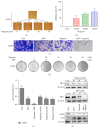Therapy Effects of Wogonin on Ovarian Cancer Cells
- PMID: 29181409
- PMCID: PMC5664191
- DOI: 10.1155/2017/9381513
Therapy Effects of Wogonin on Ovarian Cancer Cells
Abstract
Background: Wogonin is a plant monoflavonoid and has been reported to induce apoptosis of cancer cells and show inhibitory effect on cancer cell growth. However, the detailed and underlying molecular mechanisms are not elucidated. In this study, we investigated the molecular and biological effects of wogonin in human ovarian A2780 cancer cells.
Materials and methods: We determined the effects of wogonin on the changes of cell cycling and apoptotic responses of cells. Western blot analysis was used to measure the effects of wogonin on protein expressions.
Results: Our results showed that treatment with wogonin inhibited the cancer cell proliferation, decreased the percentage of G0/G1 subpopulation, and reduced invasiveness of A2780 cells. Exposure to wogonin also resulted in downregulated protein levels of estrogen receptor alpha (ER-α), VEGF, Bcl-2, and Akt and increased expressions of Bax and p53. In addition, exposure to wogonin increased caspase-3 cleavage and induced apoptosis in A2780 cells. Our study further showed that MPP, a specific ER-α inhibitor, significantly enhanced antitumor effects of wogonin in A2780 cells.
Conclusion: Our results suggest a potential clinical impact of wogonin on management of ovarian cancer.
Figures




References
-
- Dudko E., Bogush T., Kolomiytsev S., et al. Quantitative analysis of estrogen receptors alpha and beta expression in ovarian cancer patients by flow cytometry. European Journal of Cancer. 2016;61:p. S71. doi: 10.1016/S0959-8049(16)61247-9. - DOI
MeSH terms
Substances
LinkOut - more resources
Full Text Sources
Other Literature Sources
Medical
Research Materials
Miscellaneous

